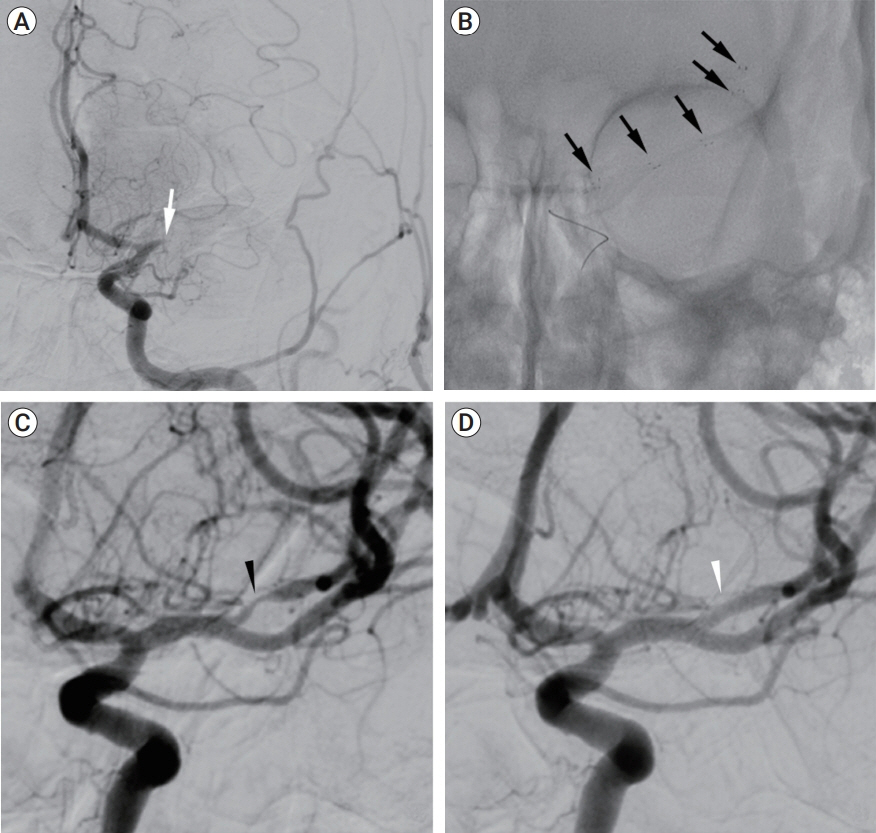J Cerebrovasc Endovasc Neurosurg.
2021 Mar;23(1):60-63. 10.7461/jcen.2021.E2020.05.001.
How to differentiate intracranial atherosclerotic disease or vasospasms after mechanical thrombectomy. Be patient or vasodilator is the secret?
- Affiliations
-
- 1Department of Interventional Neuroradiology, Universidade Federal de São Paulo, São Paulo SP, Brazil
- 2Department of Interventional Neuroradiology, Hospital Estadual Central, VitÓria ES, Brazil
- KMID: 2514340
- DOI: http://doi.org/10.7461/jcen.2021.E2020.05.001
Abstract
- Here we describe a successful mechanical thrombectomy (MT) for acute large vessel occlusion in stroke treatment with one passage (thrombolysis in cerebral infarction, TICI 3). Immediately after the withdrawing of the stent retriever, a narrowing of the middle cerebral artery was diagnosed. The rate of vasospasms during this procedure can be as higher as 41% (range from 6-41%). Here we describe our protocol when a narrowing of the artery is visualized after a stent retriever is withdrawn. A patient presented in our emergency room with National Institute of Health Stroke Scale (NIHSS) of 21, Alberta Stroke Program Early CT Score (ASPECTS) 8, computed tomography angiography revealed occlusion of the M1 segment and MT was indicated. One passage TICI Ⅲ was achieved. After that, the image showed a narrowing of the artery. We present one case of a spasm after stent retriever technique for MT, we injected vasodilator and the artery became normal in a few minutes differentiating between atheromatous stenosis and vasospasm. We present a technical note that can help to make the differentiation of vasospasm or atheromatous disease after MT with the stent retriever technique.
Figure
Reference
-
1. Akins PT, Amar AP, Pakbaz RS, Fields JD; SWIFT Investigators. Complications of endovascular treatment for acute stroke in the SWIFT trial with solitaire and Merci devices. AJNR Am J Neuroradiol. 2014; Mar. 35(3):524–8.
Article2. Berkhemer OA, Fransen PS, Beumer D, van den Berg LA, Lingsma HF, Yoo AJ, et al. A randomized trial of intraarterial treatment for acute ischemic stroke. N Engl J Med. 2015; Jan. 372(1):11–20.3. Bracard S, Ducrocq X, Mas JL, Soudant M, Oppenheim C, Moulin T, et al. Mechanical thrombectomy after intravenous alteplase versus alteplase alone after stroke (THRACE): a randomized controlled trial. Lancet Neurol. 2016; Oct. 15(11):1138–47.4. Campbell BC, Mitchell PJ, Kleinig TJ, Dewey HM, Churilov L, Yassi N, et al. Endovascular therapy for ischemic stroke with perfusion-imaging selection. N Engl J Med. 2015; Mar. 372(11):1009–18.5. Chalumeau V, Nguyen TNP, Cortese J, Chassin O, Mihalea C, Caroff J, et al. Abstract WP47: Efficacy and safety of nimodipin during mechanical thrombectomy. Stroke. 2019; Feb. 50(Suppl 1):AWP47.
Article6. Goyal M, Demchuk AM, Menon BK, Eesa M, Rempel JL, Thorton J, et al. Randomized assessment of rapid endovascular treatment of ischemic stroke. N Engl J Med. 2015; Mar. 372(11):1019–30.7. Jovin TG, Chamorro A, Cobo E, de Miguel MA, Molina CA, Rovira A, et al. Thrombectomy within 8 hours after symptom onset in ischemic stroke. N Engl J Med. 2015; Jun. 372(24):2296–306.
Article8. Lapergue B, Blanc R, Gory B, Labreuche J, Duhamel A, Marnat G, et al. Effect of endovascular contact aspiration vs stent retriever on revascularization in patients with acute ischemic stroke and large vessel occlusion: The ASTER randomized clinical trial. JAMA. 2017; Aug. 318(5):443–52.
Article9. Stent- retriever thrombectomy after intravenous t-PA vs. t-PA alone in stroke. N Engl J Med. 2015; Jun. 372(24):2285–95.10. Uchikawa H, Kuroiwa T, Nishio A, Tempaku A, Kondo K, Mukasa A, et al. Vasospasm as a major complication after acute mechanical thrombectomy with stent retrievers. J Clin Neurosci. 2019; Jun. 64:163–8.
Article
- Full Text Links
- Actions
-
Cited
- CITED
-
- Close
- Share
- Similar articles
-
- Endovascular Treatment of Large Vessel Occlusion Strokes Due to Intracranial Atherosclerotic Disease
- Significant miRNAs as Potential Biomarkers to Differentiate Moyamoya Disease From Intracranial Atherosclerotic Disease
- Primary stent retrieval for acute intracranial large artery occlusion due to atherosclerotic disease
- Mechanical Thrombectomy for Large Vessel Occlusion via the Transbrachial Approach: Case Series
- The Limitations of Thrombectomy with Solitaire(TM) AB as First-line Treatment in Acute Ischemic Stroke: A Single Center Experience



